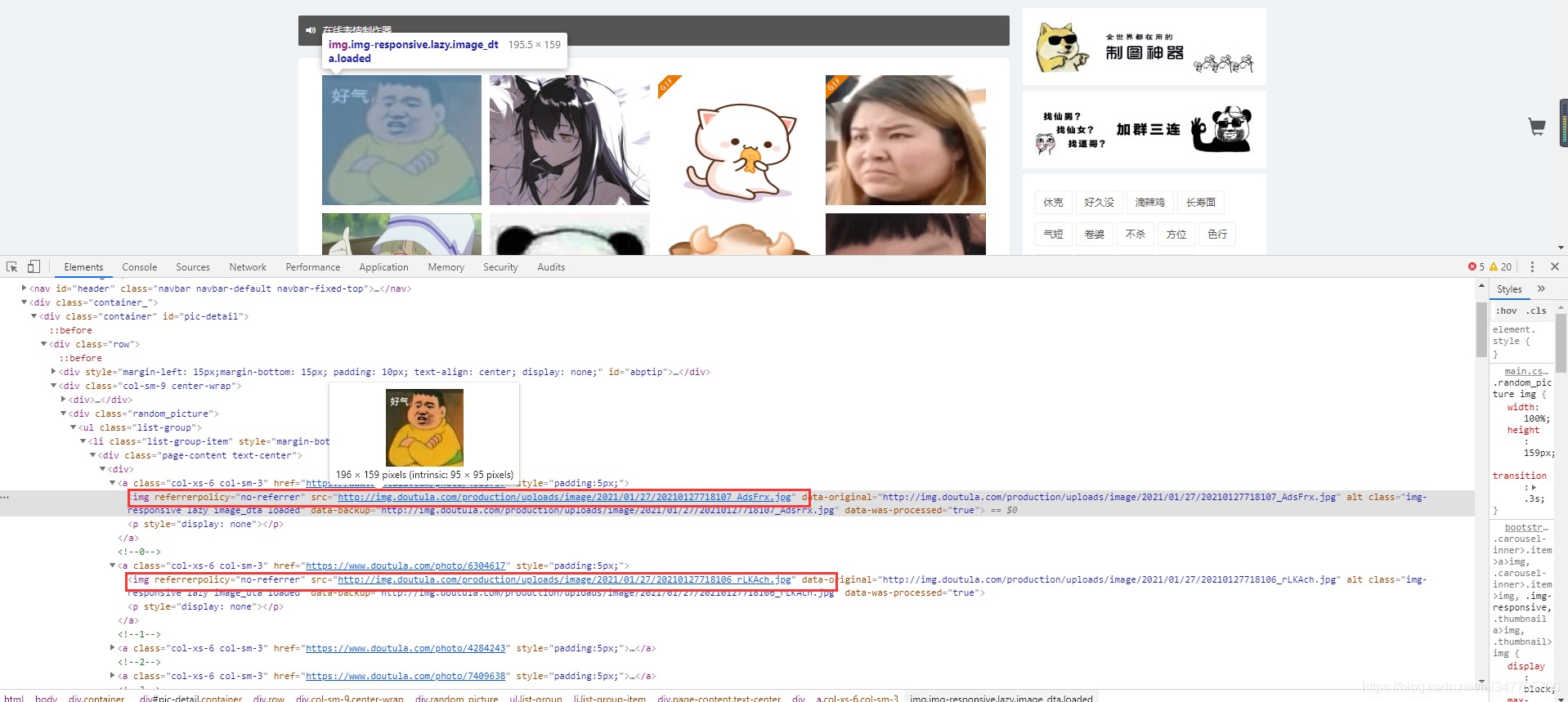本篇内容介绍了“Python多线程爬虫的使用方法是什么”的有关知识,在实际案例的操作过程中,不少人都会遇到这样的困境,接下来就让小编带领大家学习一下如何处理这些情况吧!希望大家仔细阅读,能够学有所成!
Python 3.6
Pycharm
wkhtmltopdf
re
requests
concurrent.futures
安装Python并添加到环境变量,pip安装需要的相关模块即可。
现在聊天谁还不发几个表情包?聊天时,表情包是我们重要的工具,更是拉进小伙伴们距离的好帮手,当聊天陷入尴尬境地时,随手一张表情包,让尴尬化为无形

如图所示斗图网上面的图片数据都包含在 a 标签当中,可以尝试直接请求这个网页,查看response 返回的数据当中是否也含有 图片地址。
import requests
def get_response(html_url):
headers = {
'User-Agent': 'Mozilla/5.0 (Windows NT 10.0; WOW64) AppleWebKit/537.36 (KHTML, like Gecko) Chrome/81.0.4044.138 Safari/537.36'
}
response = requests.get(url=html_url, headers=headers)
return response
def main(html_url):
response = get_response(html_url)
print(response.text)
if __name__ == '__main__':
url = 'https://www.doutula.com/photo/list/'
main(url)在输出结果中 ctrl + F 进行搜索。
这里有一个点想要注意一下,我用python请求网页所给我们返回的结果当中,包含图片url地址是:
data-original="图片url"
data-backup="图片url"
如果想要提取url地址的话,可以用parsel 解析库,或者 re 正则表达式。之前都是使用的parsel,本篇文章就用 正则表达式吧。
urls = re.findall('data-original="(.*?)"', response.text)import requests
import re
def get_response(html_url):
headers = {
'User-Agent': 'Mozilla/5.0 (Windows NT 10.0; WOW64) AppleWebKit/537.36 (KHTML, like Gecko) Chrome/81.0.4044.138 Safari/537.36'
}
response = requests.get(url=html_url, headers=headers)
return response
def save(image_url, image_name):
image_content = get_response(image_url).content
filename = 'images\\' + image_name
with open(filename, mode='wb') as f:
f.write(image_content)
print(image_name)
def main(html_url):
response = get_response(html_url)
urls = re.findall('data-original="(.*?)"', response.text)
for link in urls:
image_name = link.split('/')[-1]
save(link, image_name)
if __name__ == '__main__':
url = 'https://www.doutula.com/photo/list/'
main(url)
3631页的数据,什么表情都有,嘿嘿嘿
import requests
import re
import concurrent.futures
def get_response(html_url):
headers = {
'User-Agent': 'Mozilla/5.0 (Windows NT 10.0; WOW64) AppleWebKit/537.36 (KHTML, like Gecko) Chrome/81.0.4044.138 Safari/537.36'
}
response = requests.get(url=html_url, headers=headers)
return response
def save(image_url, image_name):
image_content = get_response(image_url).content
filename = 'images\\' + image_name
with open(filename, mode='wb') as f:
f.write(image_content)
print(image_name)
def main(html_url):
response = get_response(html_url)
urls = re.findall('data-original="(.*?)"', response.text)
for link in urls:
image_name = link.split('/')[-1]
save(link, image_name)
if __name__ == '__main__':
# ThreadPoolExecutor 线程池的对象
# max_workers 最大任务数
executor = concurrent.futures.ThreadPoolExecutor(max_workers=3)
for page in range(1, 3632):
url = f'https://www.doutula.com/photo/list/?page={page}'
# submit 往线程池里面添加任务
executor.submit(main, url)
executor.shutdown()“Python多线程爬虫的使用方法是什么”的内容就介绍到这里了,感谢大家的阅读。如果想了解更多行业相关的知识可以关注亿速云网站,小编将为大家输出更多高质量的实用文章!
亿速云「云服务器」,即开即用、新一代英特尔至强铂金CPU、三副本存储NVMe SSD云盘,价格低至29元/月。点击查看>>
免责声明:本站发布的内容(图片、视频和文字)以原创、转载和分享为主,文章观点不代表本网站立场,如果涉及侵权请联系站长邮箱:is@yisu.com进行举报,并提供相关证据,一经查实,将立刻删除涉嫌侵权内容。
原文链接:https://my.oschina.net/u/4848094/blog/4934650